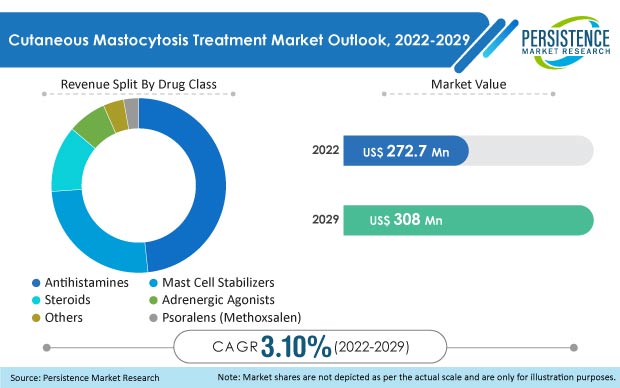Cutaneous Mastocytosis Market Segmented By Antihistamines, Steroids, Mast Cell Stabilizers, Adrenergic Agonists, Psoralens Drug Class in Oral, Injectable, Topical Administration
Industry: Healthcare
Published Date: May-2022
Format: PPT*, PDF, EXCEL
Delivery Timelines: Contact Sales
Number of Pages: 213
Report ID: PMRREP20869
Cutaneous mastocytosis is a very rare condition that often affects children under the age of two. The disease frequently causes an increase of mast cells in the skin, bone marrow, liver, digestive tract, and various other organs of the body. Between 2013 and 2021, the Global Cutaneous Mastocytosis Treatment Market had a CAGR of 3%, and it is projected to witness a CAGR of 3.1% between 2022 and& 2026 because of an increase in frequency of detection and diagnosis. The global Cutaneous Mastocytosis Treatment market is expected to be worth $308 million by 2026.
| Attribute | Key Insights |
|---|---|
|
Cutaneous Mastocytosis Treatment Market Size (2022) |
US$ 272.7 Mn |
|
Projected Market Value (2026) |
US$ 308 Mn |
|
Global Market Growth Rate (2022-2026) |
3.1% CAGR |
|
Share in parent market |
0.2% |
The market for Cutaneous Mastocytosis Treatment is valued at US$ 272.7 million in 2022 and expected to witness a CAGR of 3.1 percent from 2012 to 2026. Cutaneous Mastocytosis is a rare illness for which there is no permanent cure as of now; but several medications such as antihistamines, proton pump inhibitors, steroids, and others are being used to relieve symptoms. Leading market companies are increasing their investments in R&D to discover therapeutic alternatives that can successfully eradicate the symptoms of Cutaneous Mastocytosis. The primary drivers propelling the market growth are increased awareness regarding the disease and rising usage of medications used to treat and minimize the symptoms of Cutaneous Mastocytosis.
One of the primary reasons driving the growth of the Cutaneous Mastocytosis Treatment Market is increased awareness about Cutaneous Mastocytosis, its diagnosis, and treatment. The increased understanding of the symptoms and treatment has prompted parents of infants to seek medical attention, which is boosting the rate of diagnosis and treatment requirements in cases with Cutaneous Mastocytosis. Various non-profit organizations and government entities are emphasizing on spreading awareness about Cutaneous Mastocytosis, which is expected to promote market growth in the coming years.

Despite the fact that there is no permanent cure for Cutaneous Mastocytosis, Photochemotherapy (PUVA) has been identified as an effective combination of the drug Psoralens and long-wave ultraviolet radiation to treat Cutaneous Mastocytosis is acknowledged and practiced by many doctors. Photochemotherapy has shown promising outcomes and is increasingly being used as a treatment option for Cutaneous Mastocytosis. This trend is projected to fuel market growth over the forecast period.
Increasing investment in research and drug development by the major market players for discovering innovative treatment options for Cutaneous Mastocytosis is likely to accelerate the market growth of the Cutaneous Mastocytosis Treatment Market during the forecast period. Novel diagnostic and prognostic factors are being established to make therapy easier and more efficient. Furthermore, new advancements in pathogenesis are likely to create new opportunities for improved disease management, which will promote the expansion of the Cutaneous Mastocytosis Treatment Market.
Regardless of the fact that there is no cure available at present, the cost of treatment and the medications necessary to relieve the symptoms of Cutaneous Mastocytosis is extremely expensive. Photochemotherapy is emerging as a popular treatment option for Cutaneous Mastocytosis; but a patient with Cutaneous Mastocytosis requires 10 to 15 sessions every month, which is not affordable for the majority of middle and low-income families. As a result, the high cost of therapy and medication is a key impediment to market expansion. Apart from that, the adverse effects of various treatment drugs are also a barrier to market growth.
“Decrease in Consultations for Treatment”
The COVID-19 pandemic had a negative impact on the market for Cutaneous Fibrotic Treatment. The decline in the frequency of consultations for treatment at hospitals harmed the market but due to the relaxation of Covid-19 restrictions in the second half of 2021, the number of patients seeking treatments has increased.
The Cutaneous Mastocytosis Treatment Market is highly fragmented and dominated by big pharmaceutical companies with diverse product portfolios. As there is no cure for Cutaneous Mastocytosis, market players are working on finding novel treatment options. Major players in the market are engaging in mergers and acquisitions as well as collaborating with small and medium-sized companies to increase their market share.
| Attribute | Details |
|---|---|
|
Forecast Period |
2022-2026 |
|
Historical Data Available for |
2013-2021 |
|
Market Analysis |
US$ Mn/Bn for Value |
|
Key Regions Covered |
|
|
Key Countries Covered |
|
|
Key Market Segments Covered |
By Drug Class |
|
Key Companies Profiled |
|
|
Customization & Pricing |
Available upon Request |
Cutaneous Mastocytosis Treatment Market by Drug Class
Cutaneous Mastocytosis Treatment Market by Route of Administration
Cutaneous Mastocytosis Treatment Market by Region
To know more about delivery timeline for this report Contact Sales

In 2022, the Cutaneous Mastocytosis Treatment Market stands at USD 272.7 million, and it is expected to reach USD 308 million by 2026 at a CAGR of 3.1%.
Cutaneous Mastocytosis Treatment Market exhibited a CAGR of 3% between 2013 and 2021.
High cost of treatment and medication are the key restraints in the Cutaneous Mastocytosis Treatment Market.
Increasing awareness about disease symptoms and increased investment in research and drug development are the key factors driving the growth of the market.
Pfizer Inc., Johnson & Johnson, and Sanofi are among the top players in the market.